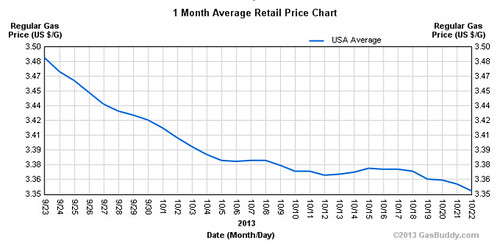Numerous news outlets are republishing the AAA prediction that gasoline prices will drop to levels not seen since 2011, when the average price of gas nationwide retailed for under $3.20 per gallon.

The chart above shows the average price of gas in the United States over the past month, as tracked by gas price tracking service Gas Buddy. The AAA points at this chart and the dropping price of crude oil and predicts the price of gasoline will drop another 15 to 20 cents per gallon by Christmas.
I’ve dismissed the opinions of oil marketing expert Trilby Lundberg before, but in this case I agree with her recent assessment that prices won’t drop much more. Thanks to the Federal government shutdown, nearly a million Americans didn’t drive to work during the first two weeks of October, and uncertainty leading to the shutdown put the brakes on economic activity nationwide.
We’re still on shaky economic ground, but it’s marginally more firm than the quicksand of just 10 days ago. More economy = more spending = more driving in America, so I think we won’t see much movement in the price at the pump.
File this under Prognostications. Feel free to come back in January to mock me. Bike and other transportation news below.
Yet Another Study (this one from MIT) shows car exhaust kills people.
No bike lanes for El Camino Real in Mountain View in spite of the regional Grand Boulevard initiative.
Public access to some of those corporate shuttle buses in Mountain View?
Bike to work event raises awareness in Santa Cruz County, California.
Citizens speak out with their suggestions to prevent bike theft in Santa Cruz.
Cultivating conversations at Bike Bike New Orleans.
San Francisco Muni bus kills 78 year old cyclist Cheng Jin Lai.
Elly Blue on the a simple solution to the dangers of car exhaust.
I still don’t quite get how gas isn’t getting exponentially expensive. It peaked long ago in the US, and peaked worldwide a handful of years ago (2004?) but somehow prices still are “reasonable.” Seems fishy. This bubble has to burst sometime.
Bad headline… almost didn’t read the post and see the nice bike links at the bottom.
Several things are happening:
* $3.30+ seems “reasonable” today, but it wasn’t too long ago that we considered this an outrageous price.
* Refined products (gasoline, diesel, aviation fuel, etc) is traded on a global market. The United States is able to pay more for fuel than some emerging economies. California, for example, imports refined products from Pacific Rim nations like Malaysia, because the refineries there make more money shipping it here and selling to the USA market than they can delivering to local farmers and fishermen, who rely on the fuel for irrigation pumps and boat motors. This results in rising food prices in those faraway places, sometimes to the point of hunger. This transfer of supply keeps prices manageable for the USA, and the detriment to people 5,000 miles away is mostly invisible to us.
* The “recovery” from recession has been stubbornly slow. We still have a lot of people out of work, and one of the reasons unemployment is dropping (we’re at 7.2% in the latest jobs report) is because people are removing themselves from the job market. Fewer workers = fewer commuters = less gas to burn.
* Higher gas prices are changing behavior. Vehicle miles traveled has dropped over the past decade, people are buying more fuel efficient cars, and more people ride transit or bikes to work. A modest change of two or three percent makes a noticeable difference in the demand and price for gas. Our demand for gasoline has been steadily declining since 2008 (although there seems to be a slight uptick in demand this year over 2012).
* Finally, gas prices at levels approaching $4 / gallon support the cost and risk of “enhanced recovery techniques” e.g. fracking or hydrofracking, insanely expensive deep water rigs, exploration in more extreme environments, and so forth. More efficient refineries also makes financial sense at our current price levels.